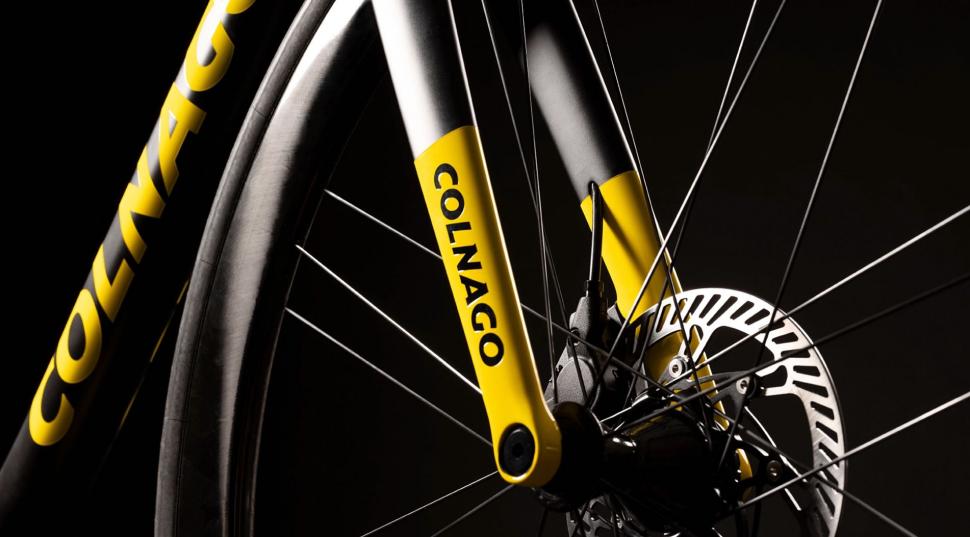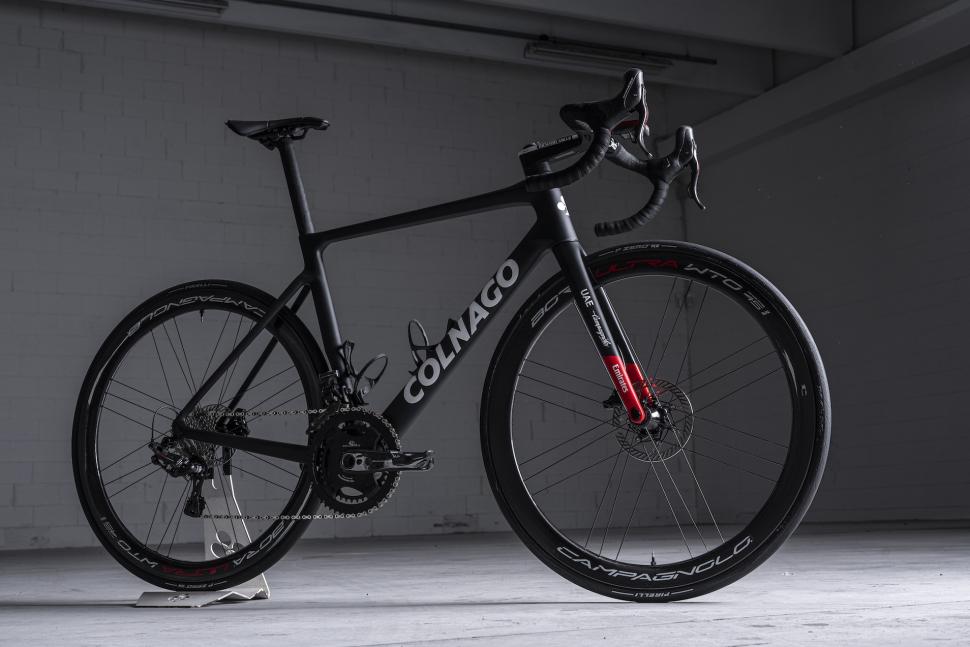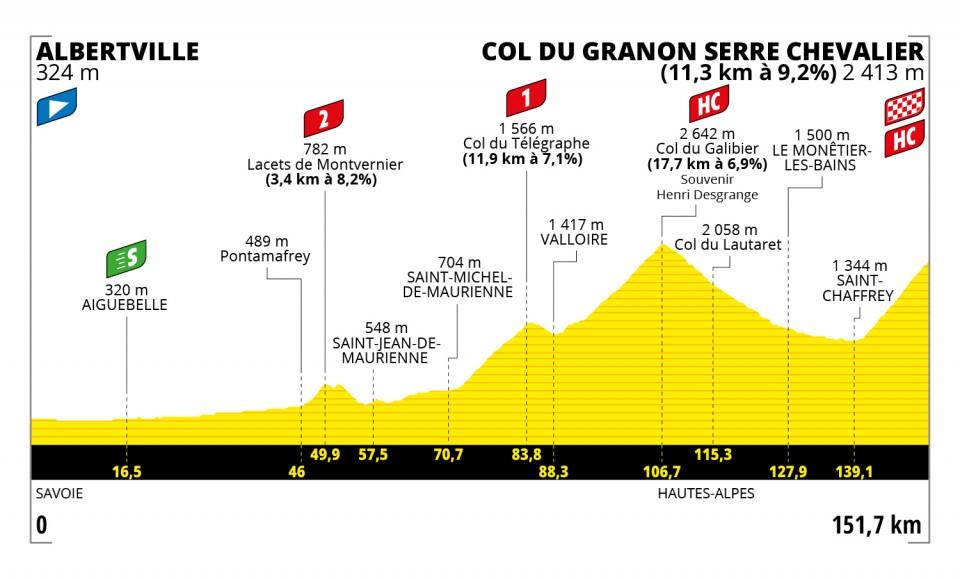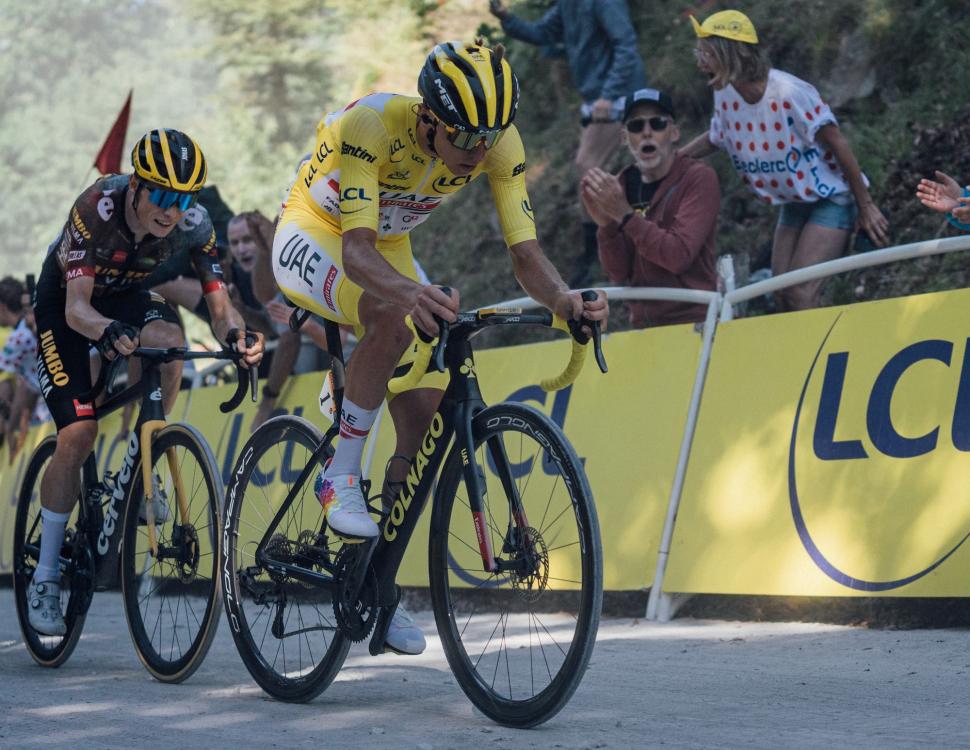- News
- Reviews
- Bikes
- Accessories
- Accessories - misc
- Computer mounts
- Bags
- Bar ends
- Bike bags & cases
- Bottle cages
- Bottles
- Cameras
- Car racks
- Child seats
- Computers
- Glasses
- GPS units
- Helmets
- Lights - front
- Lights - rear
- Lights - sets
- Locks
- Mirrors
- Mudguards
- Racks
- Pumps & CO2 inflators
- Puncture kits
- Reflectives
- Smart watches
- Stands and racks
- Trailers
- Clothing
- Components
- Bar tape & grips
- Bottom brackets
- Brake & gear cables
- Brake & STI levers
- Brake pads & spares
- Brakes
- Cassettes & freewheels
- Chains
- Chainsets & chainrings
- Derailleurs - front
- Derailleurs - rear
- Forks
- Gear levers & shifters
- Groupsets
- Handlebars & extensions
- Headsets
- Hubs
- Inner tubes
- Pedals
- Quick releases & skewers
- Saddles
- Seatposts
- Stems
- Wheels
- Tyres
- Health, fitness and nutrition
- Tools and workshop
- Miscellaneous
- Cross country mountain bikes
- Tubeless valves
- Buyers Guides
- Features
- Forum
- Recommends
- Podcast
TECH NEWS
 2022 tdf Pogacar stage 11 yellow colnago SW Pix Zac Willimas lead
2022 tdf Pogacar stage 11 yellow colnago SW Pix Zac Willimas leadDid disc brakes get Pogacar dropped?
The cycling community had quite the shock on Stage 11 of the Tour de France yesterday when Tadej Pogacar cracked on the Col du Granon, conceding 2'51" to Jonas Vingegaard on the 11.4km climb. The anti-disc brake brigade wasted no time in lighting up Twitter to blame the defeat on Pogacar's disc brakes, something he ditched on summit finishes in previous years... but were the Slovenian's brakes in any way to blame for his capitulation?
Of course it is worth pointing out that Jonas Vingegaard, winner of the stage and now proud owner of the yellow jersey, was also using disc brakes on his Cervelo R5, so it's a rational argument to say that it was the legs and team strategy that did the talking rather than the equipment.
Presumably, the reason that Pogacar's bike is under the spotlight is that in previous years at the Tour de France, the UAE Emirates rider has switched out his V3Rs disc brake frame for a rim brake model when tackling particularly arduous summit finishes.
> Check out the bikes that have been ridden to each stage victory at the 2022 Tour de France
The switch to rim brakes is speculated to save around 300g from the total weight of the bike, and this seems realistic given that the 12-speed Campagnolo rim brake groupset is around 200g lighter than the equivalent disc version. The additional 100g of weight saving will be from the Campagnolo wheels, which Pogacar has previously switched out for the tubular version as opposed to the tubeless tyres that he usually runs.
> A closer look at the Campagnolo parts that propelled Pogacar to victory
Of course, Pogacar is on a completely different bike this year, the Colnago 'Prototipo' which is rumoured to be the V4Rs, a direct replacement for last year's bike the V3Rs. I was initially sceptical that this would weigh any more than the UCI weight limit of 6.8kg, but there are unconfirmed claims that the bike Pogacar rode for Stage 11 weighed in at 7.2kg.
> Tadej Pogacar spotted riding an unreleased Colnago
If this is indeed the case then Pogacar potentially had a 400g penalty over his rivals. Does the rim brake brigade, therefore, have a point?
For the sake of simplicity, we'll just focus on the final climb of the day, the Col du Granon, and ignore any minuscule differences in aerodynamics between a disc brake and rim brake bike when travelling uphill at an average of 17.5kph.
The climb in question
The Col du Granon looked absolutely savage, especially coming at 139.1km into the stage after tackling other monstrous climbs such as the Col du Telegraphe and Galibier. The climb has a fairly constant gradient of 9.7% over its 11.4km length, peaking at just under 15%.
This is the second time that the Col du Granon has been used on the Tour de France, There were fireworks last time as well, with Greg Lemond going on to beat Bernard Hinault in the 1986 edition.
The maths
There are all sorts of software that can help us predict how much difference additional weight can make and due to the gradient and relatively low speeds this should give us reliable results. For the purpose of this we're going to use the free Bike Calculator software.
First it's a job of putting in the known parameters such as the elevation, distance and gradient of the climb, as well as Pogacar's latest known weight of 66.0kg and the bike's rumoured weight of 7.2kg.
Looking at Pogacar's Strava upload, we know that the climb actually took him 38:42 which is 17.5kph for the climb. We'll be assuming no headwind and drafting effect for both scenarios.
> Strava launches new section for Tour de France with pro rider uploads all in one place
Now let's run the software again, but with a bike weight of 6.9kg. That seems fair as it's unrealistic that rim brakes could save more than 300g; to save further weight Pogacar would probably have to ditch the rather hefty SRM chainset.
Speaking of power meters, the software predicts that to ride the climb at the speed of Pogacar an average power of 398 watts needs to be held. We'll plug that number back in with the updated bike weight.
The results
At the same watts, the same conditions and all else being identical, a bike weight of 300g less would save Pogacar ~8 seconds over the entirety of the climb; so although not insignificant, certainly not enough to have toppled any of the riders in front of him. Sorry rim brake lovers...
Should Pogacar swap bikes?
When Grand Tours can be won by just seconds, should Tadej Pogacar be switching bikes to something lighter? Well, other than sponsor obligations there are some other advantages to ditching the rim brakes, namely descending confidence. There's also the small issue that the new Colnago Prototipo is very unlikely to even be available in rim brake form. This new bike is likely lighter, stiffer and more aerodynamic than the old model hence, why it's the rider's bike of choice.
There's also the fact that our calculations are kind of a worst-case scenario. The actual weight penalty is likely to be closer to 200g rather than 300g, bringing the difference on the Col du Granon down to just 5 seconds.
In my opinion, Pogacar would be a lot better off trying to save weight elsewhere; for example, his saddle isn't the lightest and the SRM power meter is definitely one of the heavier in the peloton. The Col du Granon then was much more to do with legs, fuelling and team strategy than the weight of a Cadbury chocolate bar.
Do you think that Pogacar should have used his old rim brake bike? Let us know in the comments below...
Jamie has been riding bikes since a tender age but really caught the bug for racing and reviewing whilst studying towards a master's in Mechanical engineering at Swansea University. Having graduated, he decided he really quite liked working with bikes and is now a full-time addition to the road.cc team. When not writing about tech news or working on the Youtube channel, you can still find him racing local crits trying to cling on to his cat 2 licence...and missing every break going...
Latest Comments
- chrisonabike 0 sec ago
I think a simpler approach (and probably more effective than current) would be a different kind of machine. Dust off ERNIE and set odds of...
- rct 3 min 50 sec ago
Also Bernard Hinault, although not in P-R, injuring his knee on the cobbles in the TdF that caused him to withdraw with tendonitis that affected...
- Car Delenda Est 15 min 44 sec ago
He's right: don't snitch
- Bmblbzzz 21 min 20 sec ago
Where are Zebedee and Ermintrude when you want them?
- Steve K 34 min 15 sec ago
Update on this: apparently it's all their Ti frames ever, except the HT Ti (no, no idea why). However, it's not transferable.
- Oldfatgit 1 hour 7 min ago
Cough *plotaroute.com*
- lonpfrb 1 hour 16 min ago
Sympathy is the least we owe Sir Bradley for his high achievement representing Britain. It takes a bit more life experience to understand the peaks...
- David9694 1 hour 18 min ago
Anger over Cornwall Council decision to offload 19 busy car parks...
- SimoninSpalding 3 hours 13 min ago
I have a Ragley Trig, which is steel, has masses of clearance plus everything needed for racks, mudguards. I have it set up with a 2x10 Campag...









Add new comment
19 comments
The bike weight comparison is meaningless. To make a claim that disc brakes cost him the stage AND over two minutes lost to Vingegaard ignores a. the combined Pogacar+bike weight and b. the tactics used by Jumbo-Visma to pressure Pogacar into chasing down breaks made by several J-V riders. To write an article suggesting that a 200g difference between rim and disc options might have led to such an unexpected result is spurious at best. It's just ill-founded conjecture. It's not even that a rim-braked bike featured with the significant participants in this duel. Classic situation where a rider has been elevated to the point of the unbeatable and found himself exposed to a resourceful team which had found a plan and executed it perfectly. Now everyone who believed the 'unbeatable' bit is scrabbling around for reasons to explain away their mistaken assumption.
The article doesn't suggest that at all, it investigates the possibility that it made a difference and concludes:
Always best to read all the way to the end before rushing to rubbish an article for something it never said.
Given his rivals were also on disk brakes, the answer must be no, surely.
The thing is that Pogacar's Colnago with discs weighs 7.2kg, whereas the Pinarello Dogma F is right on the UCI limit of 6.8kg and JV's Cervelos are about the same. So I suppose the question is not did Pogacar's disc brakes cost him, but did Colnago's failure to build a bike that could be on the UCI weight limit with disc brakes cost him.
Yes, absolutely. The question "did the extra weight of Pog's bike cost him" is a much more valid one.
Do you really think that those 100gr frame weight makes the difference ? I will help you. I have built a full on V3rs discs with the heavy frozen red paint in size 52s with 48/56 wheels weight 6.7kg including bottle cage and Garmin mount.Campagnolo is heavier then dura ace, deda handlebar is heavier then advertised and found a stiff integrated alternative, seatpost can be changed by the zero setback that is considerably lighter, bora wheels are heavy, fit a rotor carbon crank with power2max meter and there you are.
If you take the regular paint and size 50s take the darimo seatpost and lower height wheels you can easily go below 6.5kg
But thinking out of the box and not sticking to sponsors if they can't deliver makes you not able to meet the minimum
You do know that they're not allowed to ride bikes that weigh less than 6.8kgs, right? Not sure what point you're trying to make.
I'm very wel aware of that. The point I wanted to make is that you hear on several places that it is difficult to get the v3rs to the legal limit with discs and that is simply not true. Yup if you need to stick to your Italian brand yes but that can hardly be attributed to the frame.
5-10 seconds on Col du Granon. Then 3 more summit finishes on Alpe d'Huez, Peyragudes, Hautacam, so (if similar efforts needed) that 20-40 seconds across the Tour.
So it's not completely insignificant. Tours have been lost by less.
That's what I thought, 8 seconds over a 40 minute climb, 12 seconds per hour of climbing, how many hours of really hard climbs are there in the average Tour, 25? That's about 3 minutes 20s, considerably more than his current defecit. If he comes second by less than that margin it'll certainly cause debate. Along with the effect of G's gilet on the ultimate outcome, of course.
That's not how it works, though. Until he was dropped on the Granon it was pretty much about overall wattage expenditure. Depending on aerodynamics on disc vs rim, it's probably marginal.
Once he was dropped, he probably lost a handful of extra seconds. But weight isn't everything on a climb: power transfer and comfort play a part.
(I'd still want a 6.8kg bike for the mountain stages, though.)
Agree, but rim or disc aren't factors in those things.
Yep. They climbed Granon at a VAM of 1620 in 39 mins. Taking an extra 300g of mass upwards at that rate is 1.32W. (1620/3600 * 0.300 * 9.81) so firmly in the "marginal" range, but the same range of gain as a £700 OSPW Aero cage.
Having watched Pidcock descend as he did, I do believe that the disc system let him pull back way more than 5-10 seconds than if he was using rim brakes on carbon wheels, so it's all about trade-offs at the end of the day.
I wonder (not disagreeing, just wondering); I saw a professional a while back (can't remember who I'm afraid, but a reasonable name) who said that they push it so close to the limit on downhills that quality of braking is not the most important thing, they were aiming to use the absolute minimum amount of brake they could get away with so neither system was being pushed anywhere close to the limit. If I recall correctly, he said if he was riding somewhere like an urban environment where he might have to make emergency stops he would take disc brakes every time, but on a full gas mountain descent in dry weather in a race he didn't really feel it made much odds. I wonder if anyone has comparative figures showing that riders are descending faster in the disc-brake era?
WTF. Perhaps the most ridiculous headline I've seen on Road CC - hang your heads in shame.
Descending confidence is something you have made up. There's no tangible reason to ditch rim brakes for road racing.
Tell that to Tom Pidcock.
Risk compensation goes both ways.
The Col du Granon then was much more to do with legs, fuelling and team strategy than the weight of a Cadbury chocolate bar.
From personal experience my ride home from work is usually slower than my ride to work and I've usually consumed a Cadbury chocolate bar or two.
Of course it could be because I've spent all day moving pallets of them around the warehouse, who knows?
If rim brakes won him the last 2 TDF's while his rivals rode discs then he's obviously massively overrated and his fanboys need to pipe down.